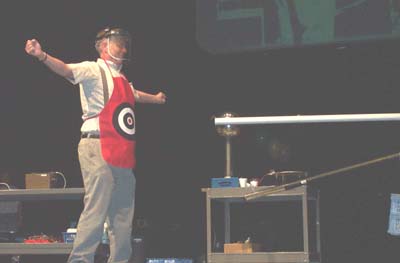

We can estimate the final speed of the ball. We assume that the force on the ball is due to the atomspheric pressure of the air on the back half of the ball. This results in a net forward force which is equal to atomospheric pressure times the cross-sectional area of the ball:
F = PA = P(pi)r2 = (100000 Pa)(3.14)(0.019 m)2 = 110 N = 25 lb.
The acceleration of the ball is thus given by
a = F/m = (110 N)/(0.0023 kg) = 49000 m/s2 = 4900 g.
We finally obtain the velocity of the ball as it exits the end of the tube:
v2 = 2ax = 2(49000 m/s2)(3.3 m)
or
v = 570 m/s = 1300 mph
which is about 1.7 times the speed of sound. This simple calculation overestimates the final speed since we have neglected the viscosity of the air, the air which leaks around the ball, and the limitations of the speed at which a pressure front can travel.
We measured the speed of the ping-pong ball as it reaches the end of the tube. We attached a short section of clear tube at the end and then sent two laser beams through the path of the ball. The speed we obtained from this measurement was 270 m/s = 600 mph.
For more detailed optical diagnostics of the ping-pong cannon, see R. W Peterson, B. N. Pulford, and K. R. Stein, "The Ping-Pong Cannon: A Closer Look," The Physics Teacher 43, 22-25 (2005).
For the sake of clarity in the following discussion, we will call the ends of the tube A and B. The ping-pong ball is inserted into end A. When fired, the ball exits end B.
We drilled a hole near end A of the tube and installed a fitting for the tube to the vacuum pump.
We insert a ping-pong ball into end A of the tube and seal that end with a small square of a thin sheet of aluminized milar (obtained from an emergency blanket). (Note that you can simply seal both ends of the tube with a piece of wide clear packaging tape. This is how we did it at first. However, the present method is easier to use and more reliable.)


The milar is held in place by an end piece which fits tightly over end A of the tube.


End B of the tube is sealed using a piece of plastic cut from the bottom of a drinking cup. We turn on the vacuum pump to hold this piece in place. End B of the tube must be very smooth in order to hold a good vacuum. The ABS tube was not quite wide enough so we added a short piece of clear polycarbonate tube of the correct diameter (OD about 2 inches) to end B.
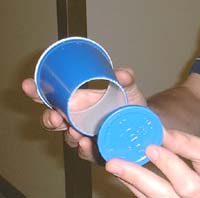

We aim the cannon into a large plastic jar to prevent the shattered pieces of the ping-pong ball from spraying into the room. The jar is attached to a large cylinder with a slit cut through it to hold flat objects such as a file folder.
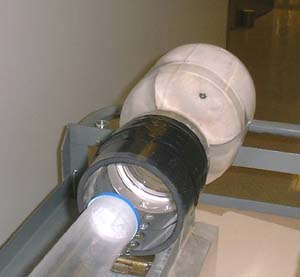

The cannon is now ready to fire.
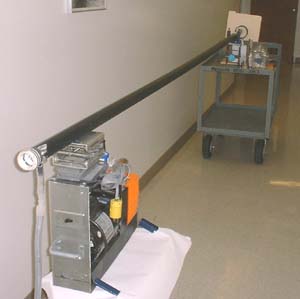
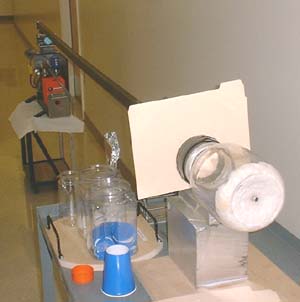
The ping-pong ball easily punctures the file folder. It can also puncture the cover of a three-ring binder.

The ping-pong cannon was demonstrated at the national meeting of the American Association of Physics Teachers, August 2002, in Boise, Idaho. As a finale, Harold Stokes became a human target (no artificial padding or protection). The ping-pong ball stings, leaving a red welt. (The cannon shown below was actually built by Zig Peacock at the University of Utah using PVC tubing.)
